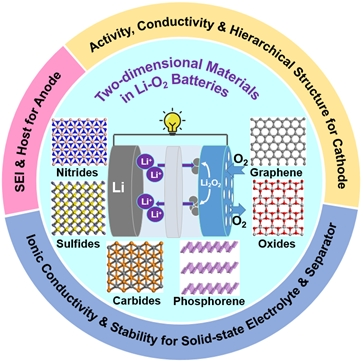Y.J. Ding, Y.J. Li, M. Wu, H. Zhao, Q. Li, Z.-S. Wu*
Energy Storage Materials, 2020, 31, 470-491.
DOI: 10.1016/j.ensm.2020.07.041 [PDF]

Li-O2batteries have drawn considerable interests owing to their highest theoretical energy density among the reported rechargeable batteries. However, Li-O2batteries are facing severe challenges in the low round-trip efficiency and poor cycling stability. Recently, two-dimensional (2D) materials with large surface area, tunable electrical/ionic conductivity, exceptional chemical and mechanical stability are emerging as a competitive candidate for Li-O2batteries. Herein, this review summarizes the key challenges and recent advances of 2D materials, serving as multi-functional roles in the design of advanced cathodes, development of solid-state electrolytes and separators, and protection of lithium anodes for high-energy-density nonaqueous Li-O2batteries. Firstly, the current status is introduced to highlight the significance and bottlenecks of Li-O2batteries. Second, the state-of-the-art 2D materials are exampled to illustrate their key roles in cathodes, electrolytes, separators and anodes. Specifically, 2D materials with high electrical conductivity, hierarchically porous structure and enriched functionalities are very promising for design of ideal cathodes that can significantly facilitate the transfer of electrons and mass, offer enough accommodation space for discharge products. Moreover, 2D materials modified separators and solid-state electrolytes with superionic conduction and outstanding stability can greatly boost ionic mobility and prolong the cycling life. Besides, nanostructure engineering of stable solid electrolyte interface film and Li metal anode using 2D materials as coating layers and lithophilic hosts with high chemical stability and mechanical strength can effectively suppress the growth of Li dendrites during plating/stripping. Finally, the future challenges and development directions of Li-O2batteries based on advanced 2D materials are briefly discussed.